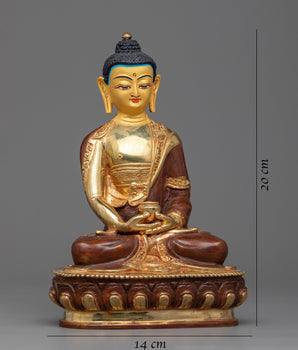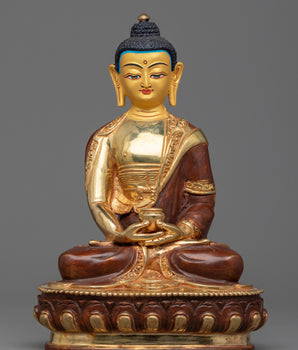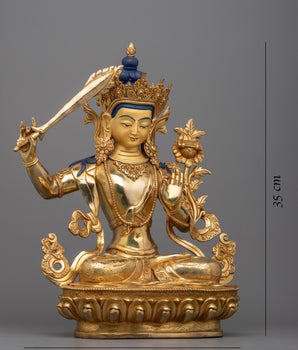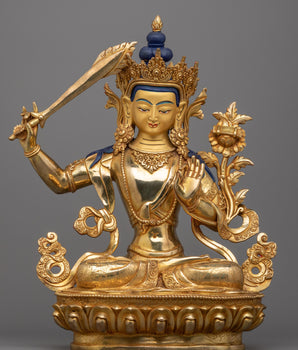Vajrapani and Bhutadamara: Guardians of Spiritual Strength and Purification
Vajrayana Buddhism includes Vajrapani and Bhutadamara as its two principal deities although their specific attributes highlight distinct features to support spiritual development and protect power. Most Buddhist traditions view Vajrapani as both an exceptional bodhisattva that introduced the Mahayana teachings plus a depictions of the Buddha's formidable qualities. Practitioners require strength from this deity for overcoming obstacles that lead them to enlightenment through their battle against ignorance. People in Mahayana Buddhism as well as Vajrayana and Tibetan Buddhism worship him because he stands as a protector of the Dharma through both compassionate and forceful manifestations.
The Sakya school of Tibetan Buddhism presents Vajrapani through a different manifestation as Bhutadamara who defends practitioners against spiritual obstacles and demonic spirits. Bhutadamara constitutes a distinctive manifestation of Vajrapani that dedicates itself to fighting malignant spirits then invading demons and external factors constraining spiritual progress. The active energy source of tantric practitioners enables them to perform rituals of exorcism and negative influence divestment as part of their spiritual work. This article studies Vajrapani together with Bhutadamara through an evaluation of their default attributes and spiritual functions along with their sacred artwork creations and one-of-a-kind sacred practices.
This blog focuses on uncovering the precise tasks these divine entities execute within Buddhist traditions because it helps better comprehend their spiritual role and their help for both inner peace and exterior threats.
The Essence of Vajrapani

Mahayana Buddhism has recognized Vajrapani as one of its earliest and most vital divine beings since the name Vajrapani means "Holder of the Thunderbolt or Diamond" in Buddhist tradition. The ancient figure emerged as a substantial play when Buddhist teachings were established because he guarded the Buddhist doctrinal teachings (Dharma). Practitioners need the diety as an essential force because this one of the three principal bodhisattvas helps believers overcome inner and outer obstacles on their journey to enlightenment. Together with Avalokiteshvara and Manjushri, he serves as a guiding force for Buddhist practitioners.
He serves as the protector-guide for Gautama Buddha because early Mahayana scriptures show him as a strong character who ensures the Dharma remains safe. The depiction presents the required spiritual power needed to overcome ignorance and spiritual obstacles during spiritual awakening. People who invoke Vajrapani seek to fortify their spiritual dedication while eliminating ignorance because he personifies the relentless Buddha energy that removes all obstacles from their path to enlightenment.
The historical growth of the Bodhisattva manifests itself in his changing appearance throughout history. During early Buddhism Vajrapani maintained a peaceful approach but Buddhist interaction with various Asian regions prompted the emergence of his wrathful manifestation. As spiritual communities recognized the necessity of powerful guardians they shifted their perception of Vajrapani from gentle to wrathful because his divine strength could combat all spiritual hindrances and negative forces.
He holds significant importance within the Vajrayana Buddhist tradition where he performs two essential functions through his protector duties and tantric practices leadership. Most religious practitioners call upon his name to develop inner resilience along with spiritual defense mechanisms and guide themselves through obstacles toward their enlightenment process. The path to liberation demands the combination of determined discipline and compassionate openness which he taught in ways that unite his wrathful and benevolent aspects.
Expansion into Diverse Buddhist Traditions
When his worship reached multiple Buddhist schools especially in Tibet his role acquired broader complexity. A particular form became prominent in Tibetan Buddhism through the Sakya tradition as Bhutadamara Vajrapani. The distinctive form concentrates its power on confronting supernatural powers and demonic enemies to protect spiritual practitioners from external threats. Through various Buddhist traditions the diety receives generalized imagery to represent both the defense of sacred teachings alongside his commitment to protect students walking the path towards enlightenment.
Iconography
Through wrathful depictions, he expresses his protective duty for the Dharma decadently. He demonstrates his commitment to destroy enlightenment obstacles through his active menacing appearance because he does not follow other bodhisattvas who present calm images. The common artistic elements portrayed in Vajrapani statues include:
-
Vajra (Thunderbolt): He holds a vajra (thunderbolt) in his right hand. According to Buddhist symbolism, the vajra demonstrates both perpetual spiritual energy and superior capability to severe false perceptions and mental darkness as well as pain. Shape and form of this weapon stand as symbols that represent eternal strength and strong spiritual awarness.
-
Lasso: A noose or lasso, which represents the binding and subduing of evil spirits, is frequently held in the left hand. He occasionally carries a skull cup full of sacrifices. One of the main themes of Vajrayana is the marriage of wisdom and procedure, which is symbolized by the tools.
-
Wrathful Expression: His protective dedication becomes visible through his wrathful expression that combines bulging eyes and bared fangs. He displays wrathful energy as an expression of his compassionate attitude by eliminating obstacles which block spiritual advancement.
-
Dynamic Posture: His stance and imagery in warrior-ready pose shows his active work against ignorance and negativity through placing his foot on defeated adversaries. Through his stance, he demonstrates his preparedness both to defend the teachings of the Dharma and support seekers of enlightenment.
The multiple depicted elements show his absolute dedication to defend meditators from various hindrances found inside and outside of their practice. Throughout tantric practices people call upon him to receive safeguarding protection and empowerment as their spiritual guardian.
Bhutadamara Vajrapani in the Sakya Tradition

The Sakya school of Tibetan Buddhism showcases Bhutadamara as "Subduer of Demons" a specialized Vajrapani form that predominates within its teachings. The specified form of Bhutadamara delivers its protective and subduing power against negative entities which seek to obstruct spiritual advancement compared to Vajrapani's general protective function for Buddhas. External spiritual events which manifest harmfully as demonic entities, curses or supernatural forces become his main responsibility for complete subjugation. Such negative forces block spiritual advancement by creating disturbances that hurt a practitioner's mental and emotional health as well as their physical state. The direct power possessed by Bhutadamara allows believers to respect him as an essential deity because he destroys negative forces so effectively in spiritual practices that deal with challenging external and supernatural influences.
Bhutadamara Vajrapani actively participates in all Tibetan Buddhist purification and exorcism rites because of his close relationship with these spiritual practices. Spiritual and supernatural disturbances require his specific power to eliminate interferences that prevent practitioners from making spiritual advancement according to his effective practice. Bhutadamara rituals combine invocations with meditations which harness his spiritual power to cleanse environmental areas and people while removing negative energy influences. Worshippers from various spiritual backgrounds seek the assistance of this deity to remove persistent problems which stem from spiritual or cursed disturbances and other supernatural restrictions. Bhutadamara offers essential power for people who must confront significant spiritual obstacles by allegedly offering protection and clarity to surmount their challenges while maintaining their enlightenment path.
Iconography
The depiction of Bhutadamara matches basic Vajrapani depictions yet shows exclusive elements that represent his special position in the Sakya tradition. Some of these distinct features of his iconography include:
-
Multiple Arms: Bhutadamara shows characteristics different from standard Vajrapani by possessing four arms which carry tools for subduing harmful forces through their specific symbolic meanings. The spiritual tools of vajra (thunderbolt), noose and bell with skull cup form part of his representation. Each spiritual tool performs an individual function for overcoming threatening beings and making the practitioner's road free of contamination.
-
Trampling Demonic Beings: The imagery of Bhutadamara standing on defeated demonic beings indicates his total mastery over negative powers. Artist representation of the deity standing upon subdued demonic figures demonstrates his ability to remove obstacles and protect against supernatural threats.
-
Skull Garlands: The representations of Bhutadamara sometimes depict him wearing a mundamala which represents his ability to control death and ignorance through the skull garland. The skull garland transforms spiritual illusions into productive wisdom and visually illustrates constant change along with the end of attachment to ego.
-
Consort in Yab-Yum Posture: Through specific Yab-Yum depictions Bhutadamara holds a close position with his female partner which represents the unification of wisdom together with skillful means. Tantric Buddhist art depicts this imagery frequently because it shows the supreme enlightenment achieved when wisdom unites with method through union between male/female deities.
The symbolic motifs in Bhutadamara's representations show his particular role to fight off spiritual obstacles while giving followers immediate solutions for their spiritual development.
Comparative Analysis
Similarities
The sacred Buddhist practices unite Bhutadamara and Vajrapani as two manifestations which deliver protective empowerment through enlightened activities. These protectors safeguard Buddhist teachings because their role is to assist practitioners who seek enlightenment through protection against the many difficulties that arise along the path. Through their wrathful countenances they depict an active compassionate disposition which transforms rather than staying passive. The passionate force exhibits itself as wrath as practitioners need this energy to fight hostile forces which prevent their spiritual advancement. Vajrapani together with Bhutadamara present fierce compassion which gives practitioners the ability to build their inner capacity for enduring the trials they meet along their spiritual path.
Modern Buddhist rituals call upon Vajrapani in his two aspects to provide practitioners with sacred support when facing various difficulties related to their spiritual and mental and physical states. Vajrapani protects practitioners in all situations yet specifically strengthens their dedication to the Dharma practice. Bhutadamara receives special invocation in exorcism ceremonies and purification rituals because his strong expertise against demonic threats makes him critical in situations where spiritual attacks become intense. Buddhist rituals benefit from the vital interventions of these two divinities who deliver protective force and eliminate specific negative energies. The deities provide practitioners with moral support to help them overcome distractions from their path to achieve enlightenment.
Differences
-
Function and Emphasis:
-
Vajrapani emphasizes the power of the Buddhas through his role as guardian of the Dharma which he uholds in all territory.
-
Bhutadamara leads spiritual practice by focusing on the supression of specific negative forces that block spritual growth but als concentrates on supernatural and malevolent forces.
-
Iconography:
-
Vajrapani is seen holding vajra in his right hand which represents everlasting spiritual strength.
-
Bhutadamara presents multiple arms, displaying a noose, bell, and skull cup, to show his active roles between subjugation and purification tasks.
-
Role in Tantric Practice:
-
Various Buddhist traditions worldwide invoke Vajrapani during tantric practices because he bestows spiritual strength while protectng practitioners.
-
Bhutadamara plays a prominent role in advanced tantric rituals of the Sakya tradition because it leads obstacle-removing ceremonies and exorcisms.
-
Depictions of Wrath:
-
Vajrapani’s wrathful expression represents his commitment to defend Dharma while destroying all internal and external obstacles.
-
Bhutadamara’s imagery depicts him stepping on demons, demonstrating preventive exorcism instead of regular security functions.
Practices and Rituals
Vajrapani Practices
Various Buddhist traditions throughout different regions incorporate practices concerning Vajrapani. The rituals targeting this diety seek his protective ability alongside spiritual energy to defeat inner and external adversities. These practices may include:
-
Mantra Recitation: Vajrapani's mantra "Om Vajrapani Hum" constitutes one of the most widespread spiritual recitations employed to attract his protective strength.
-
Visualization Meditation: The practitioner performs Visualization Meditation by visualizing Vajrapani taking his wrathful form that clears away ignorance while driving away harmful energy around them.
-
Empowerment Rituals: The practice of empowerment through Vajrayana allows practitioners to receive Vajrapani empowerment from qualified masters to deepen their meditation and ritual practice.
-
Fire Pujas: During fire pujas some traditions honor Vajrapani through ritual offerings to purify karma and eliminate spiritual obstacles on the path to achieve enlightenment.
Bhutadamara Practices in the Sakya School
Within the Sakya tradition Bhutadamara Vajrapani functions as an important obstacle remover. His main intention through his practices exists to fight harmful forces. These include:
-
Exorcism Rituals: Religious ceremonies involving Bhutadamara function specifically for the removal of negative spiritual influences from both practitioners and other individuals.
-
Protective Sadhanas: Sakya practitioners practice structured meditative Bhutadamara-related exercises (sadhanas) to secure their protection from powerful malevolent spirits.
-
Preparatory Practices for Retreats: People going into intensive meditation retreats must participate in Bhutadamara rites for removing foreseeable obstacles.
-
Offerings and Chöd Rituals: Some practitioners of Bhutadamara use Chöd (severance) rituals to symbolically provide their ego and fears while using this paramotion to convert obstacles into enlightened understanding.
Teachings and Interpretations Across Traditions

The importance of Vajrapani differs slightly from one Buddhist tradition to another. Mahayana tradition adherents view him as the Buddha's guardian deity along with using him as the embodiment of Buddha's power and understanding. He functions as a bodhisattva through general duties that protect the Dharma while supporting practitioners to eliminate roadblocks. Vajrayana Buddhism stresses the wrathful manifestation of Vajrapani to link him with secret Buddhist practices that remove internal and external obstacles through tantric rituals.
According to the Tibetan traditions especially the Sakya school Bhutadamara Vajrapani performs direct focused remediation of adverse forces. Bhutadamara demonstrates superior importance for breaking through supernatural hindrances that stand between Vajrayana Buddhists and their spiritual advancement.
Guardians of the Dharma: Their Enduring Role
Vajrapani serves the Buddhist path through powerful protection together with Bhutadamara Vajrapani who plays a specific role as protector. The symbolical figure Vajrapani carries the name Holder of the Vajra to represent the everlasting power of the Buddhas. The appearance of his wrath symbolizes compassionate power needed for overcoming spiritual impediments while providing protection that multiple Buddhist traditions utilize. As a protector of Buddhism, he fulfills his essential function of assisting believers when they confront spiritual and worldly challenges while holding his vajra or exhibiting preparedness for combat.
The Subduer of Demons manifestation of Bhutadamara Vajrapani dedicates his power to eliminate supernatural obstacles. The Sakya Buddhist tradition keeps this deity at their disposal for ritual purposes to drive back evil spirits using different holy instruments for protection work. The visual representation of Vajrapani features him stepping on demonic figures to demonstrate his readiness to confront spiritual threats.
Despite addressing different protective domains these Buddhist divinities function together to protect followers while helping them reach enlightenment. General protection along with strength comes from Vajrapani yet Bhutadamara specializes in eradicating spiritual dangers. These two Buddhist elements make up complementary forces that provide safety and cleansing power to maintain the path toward enlightenment without obstruction.















